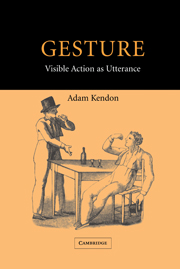Book contents
- Frontmatter
- Contents
- Acknowledgments
- 1 The domain of gesture
- 2 Visible action as gesture
- 3 Western interest in gesture from Classical Antiquity to the eighteenth century
- 4 Four contributions from the nineteenth century: Andrea de Jorio, Edward Tylor, Garrick Mallery and Wilhelm Wundt
- 5 Gesture studies in the twentieth century: recession and return
- 6 Classifying gestures
- 7 Gesture units, gesture phrases and speech
- 8 Deployments of gesture in the utterance
- 9 Gesture and speech in semantic interaction
- 10 Gesture and referential meaning
- 11 On pointing
- 12 Gestures of ‘precision grip’: topic, comment and question markers
- 13 Two gesture families of the open hand
- 14 Gesture without speech: the emergence of kinesic codes
- 15 ‘Gesture’ and ‘sign’ on common ground
- 16 Gesture, culture and the communication economy
- 17 The status of gesture
- Appendix I Transcription conventions
- Appendix II The recordings
- References
- Index
Appendix II - The recordings
Published online by Cambridge University Press: 05 February 2015
- Frontmatter
- Contents
- Acknowledgments
- 1 The domain of gesture
- 2 Visible action as gesture
- 3 Western interest in gesture from Classical Antiquity to the eighteenth century
- 4 Four contributions from the nineteenth century: Andrea de Jorio, Edward Tylor, Garrick Mallery and Wilhelm Wundt
- 5 Gesture studies in the twentieth century: recession and return
- 6 Classifying gestures
- 7 Gesture units, gesture phrases and speech
- 8 Deployments of gesture in the utterance
- 9 Gesture and speech in semantic interaction
- 10 Gesture and referential meaning
- 11 On pointing
- 12 Gestures of ‘precision grip’: topic, comment and question markers
- 13 Two gesture families of the open hand
- 14 Gesture without speech: the emergence of kinesic codes
- 15 ‘Gesture’ and ‘sign’ on common ground
- 16 Gesture, culture and the communication economy
- 17 The status of gesture
- Appendix I Transcription conventions
- Appendix II The recordings
- References
- Index
Summary
The occasions recorded in the video tapes used in the analyses reported in this book were made in ordinary settings of people talking together, in most cases while they were in pursuit of their own purposes. They include occasions such as meals, committee meetings, a casual card game, interactions between customers and vendors at market stalls, semi-public presentations by tour guides, and informal conversations. We have also used recordings in which the participants told about their childhood and youth, discussed the state of the city they live in, or talked about what they considered to be important aspects of their own local culture.
All of the recordings from Campania, Italy, all of those from Northamptonshire, England, and certain recordings from the eastern United States of America were made by myself or by students under my direction, for the purpose of collecting material for the study of communication conduct in face-to-face interaction. They were made openly, with the full knowledge and consent of the participants. In most cases it was explained to the participants that we wanted to make the recordings as a documentation of aspects of everyday life. Some of the material made in Northamptonshire was made for the benefit of a local historical society or as a documentation of the activities of a small local museum. Some of the material from Naples comes from conversations about the character of Naples and its inhabitants.
- Type
- Chapter
- Information
- GestureVisible Action as Utterance, pp. 365 - 368Publisher: Cambridge University PressPrint publication year: 2004

